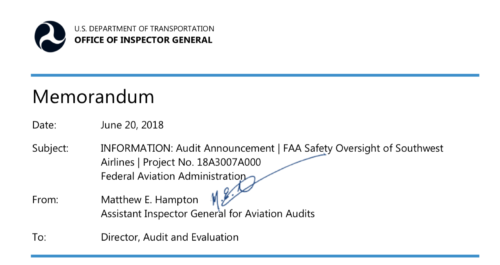“Aviation Watchdog” to Audit FAA Oversight of Southwest Airlines
The Office of Inspector General for the US Department of Transportation said Wednesday it will audit the FAA’s safety oversight of Southwest Airlines. The announcement comes two months after a Southwest flight suffered an engine failure, resulting in the first passenger fatality in the US since 2009.
A June 20 memorandum from Matthew Hampton, Assitant Inspector General for Aviation Audits, states:
We are initiating a review of FAA’s safety oversight of Southwest Airlines. Specifically, our objective is to assess FAA’s oversight of Southwest Airlines’ systems for managing risk. This review is separate from our ongoing review of FAA’s oversight of aircraft maintenance.

Office of Inspector General | Audit Memorandum
While the memorandum specifically cites Southwest’s recent incident, the primary objective is to evaluate the FAA’s 2015 requirement for air carriers to implement safety management systems. Under the requirement, air carriers must identify root causes for hazards and manage risk to prevent accidents.
Concerns Regarding FAA Oversight
Premilinary reports describe similarities between the April 2018 engine incident and an August 2016 engine incident that resulted in an emergency landing in Pensacola, Floria. Citing the 2016 incident, the Assistant Inspector General said: “It is unclear what actions the carrier took to manage the risk to prevent a future failure.”
While this audit specifically relates to Southwest, the Department of Transportation is also auditing FAA practices regarding American Airlines and Allegiant. The audit cited differences among carriers regarding their relationship with the FAA and information-sharing practices.
Another Audit Announced for Evacuation Procedures
The Inspector General’s office also said Monday it will audit the FAA’s oversight of evacuation procedures. FAA evacuation standards require an aircraft to be evacuated in 90 seconds or less. Watch this incredible video of a 2007 A380 emergency evacuation test:
The European Aviation Safety Agency (EASA) and FAA oversaw the A380’s successful 90-second-required evacuation drill of 837 passengers. To better simulate crash scenarios, half of the exits were blocked and cabin lights turned off.
Despite extensive training and certification processes, recent incidents like the 2016 American Airlines Boeing 767 engine fire reveals chaos and confusion as passengers evacuated the aircraft. Engines were still running as passengers “shouted at flight attendants” to open the doors; flight attendants eventually opened the doors before receiving evacuation orders from the pilot. All 161 passengers and nine crew survived with only minor injuries reported.
FAA evacuation standards have not been updated significantly since 1990. Changes in passenger behavior – like more people carrying on their bags – as well as increased number of seats and reduced seat pitch have raised questions about the 90-second rule. The audit objectives include,
Assessing the FAA’s development and updating of aircraft emergency evacuation standards, including how changes in passenger behavior, passenger demographics, and seating capacity, affect the standards, and (2) process for determining whether aircraft as currently configured meet evacuation standards.
Three Audits…A Cause for Concern?
The US aviation industry maintained a near-perfect safety record over the last decade. The last fatal crash was a 2009 Colgan Air flight resulting in 50 fatalities. There were no commercial jet fatalities worldwide in 2017, making it the safest year on record for commercial air travel.
Oversight is good, and ongoing audits will ensure the FAA and airlines follow stringent safety requirements. Two engine incidents, however, is not a reason to doubt the safety of Southwest Airlines. Until flight 1380 this April, Southwest had zero fatalities in its history. For a carrier flying since 1971, that’s an incredible safety record.
The responses below are not provided or commissioned by the bank advertiser. Responses have not been reviewed, approved or otherwise endorsed by the bank advertiser. It is not the bank advertiser's responsibility to ensure all posts and/or questions are answered.